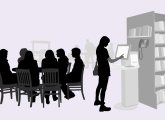With smaller budgets and more students with dyslexia, communication issues or who are recent arrivals, schools are finding it increasingly hard to make ends meet, whilst still meeting every learner’s literacy needs. Fortunately, with a little planning and some research they can make hard won resources stretch a little further – identifying and sourcing affordable technology to help with reading text, improving phonic and spelling skills, accessing high frequency spellings and subject vocabulary, planning work, recording written text, accessing the curriculum and accessing written information online. Here’s how it can be done:
Do an audit
Check what resources you already have. When I visit schools to talk about their assistive technology I often find that a mind mapping program or voice recorders are tucked away in one department and rarely used. Yet these can be a lifeline at KS3, helping with planning and organisation.
Prioritise carefully
Identify what matters most to the student. Matt was embarrassed that he could not copy off the board fast enough. When he started year 10 he found he was using up too much energy on simple clerical tasks and had no brain power left for planning and composing answers. “Everyone would be discussing the topic and I was still writing down what we had to do. The rest of my group were always having a go at me and then it took even longer.” Now he takes a photo on his phone and can refer to it any time he wants.
Consider replacing human readers
Schools really need text to speech technology such as TextHelp and ClaroRead. The JCQ Access Arrangements and Reasonable Adjustments 2016-2017 says: “Computer software which accurately reads out text, (including synthetic speech software stored on a memory stick) but does not decode or interpret the paper, may be used as a computer reader.” Schools make savings by cutting back on the number of readers and extra invigilators – but they must make sure that using such programs becomes the student’s normal way of working.
Match resources to need
Jules Daulby, literacy and language coordinator at the Thomas Hardye School in Dorchester, trialled the C-Pen Exam Reader and found that it was suitable for students who were independent, had little access to TA provision yet had poor decoding skills. Some found it a reassuring safety net and kept it in their bag in case they encountered a word they could not read. “There are also students who don’t necessarily come under the SEN radar but we will suddenly have an email from a teacher or parent saying they are concerned,” said Jules. “The pen gives them an easy option for a little bit of extra help. We know, for some students (a few of the quiet ones who may not ask for help in class) it has made a big difference to their ability to access the text.”
Keep up to date with projects and research
The world of assistive technology is constantly evolving. Recently Microsoft and the British Dyslexia Association conducted an 11-week study with 20 pupils at Knowl Hill School in Surrey, a specialist dyslexia school. They found that using Immersive Reader, part of Microsoft’s OneNote software, improved pupil’s reading comprehension and boosted their confidence.
16 out of 18 showed an improvement in their classroom behaviour, and 11 out of 16 improved their reading comprehension. Ian Fordham, director of education at Microsoft UK, said that the company was hoping to conduct a larger scale trial.
Listen to the experts!
Students with literacy problems develop strategies that serve them well both in and out of school. Many of them are good technology users and will have hints and tips about how to use tablets and phones to overcome their problems. Often, they know more than staff about free software and apps.
Some schools provide a physical or online space for students to share their knowledge. Why not avail yourself of this expertise? After all, these students are the ones who have a vested interest in finding the cheapest and most effective solutions.
About the author
Sal McKeown is a freelance journalist and author of How to Help Your Dyslexic and Dyspraxic Child, published by Crimson









